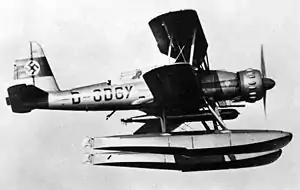Arado Ar 95
The Arado 95 was a single-engine reconnaissance and patrol biplane designed and built by the German firm Arado in the late 1930s. Ordered by Chile and Turkey, a number were taken over by the Kriegsmarine (German Navy) when World War II started.
| Ar 95 | |
|---|---|
 | |
| Role | Reconnaissance Biplane |
| Manufacturer | Arado |
| First flight | 3 December 1936 |
| Primary users | Chile Kriegsmarine |
| Number built | 42 |
| Variants | Arado Ar 195 |
Development
The Arado 95 was designed in 1935 as a two-seat seaplane, for coastal patrol, reconnaissance and light attack roles. The first prototype, an all-metal biplane powered by a BMW 132 radial engine, flew in 1936,[1] while a second prototype was powered by a Junkers Jumo 210 liquid-cooled engine. The two prototypes were evaluated against the similar Focke-Wulf Fw 62. The BMW-powered version was considered worthy of further study, and a batch of six was sent for further evaluation with the Legion Condor during the Spanish Civil War.[2]
The Arado Ar 95 was the basis for the prototype Ar 195 carrier-based torpedo bomber, which was proposed for operation from the German aircraft carrier Graf Zeppelin.[1]
Operational history

The Ar 95 was not ordered by the German armed forces, and so was offered for export in two versions, the Ar 95W floatplane and Ar 95L landplane, with a fixed, spatted undercarriage. Six Ar 95Ls were ordered by the Chilean Air Force, being delivered prior to the start of World War II.[3] Turkey placed an order for Ar 95Ws, but these were taken over by Germany at the outbreak of war.
The requisitioned Ar 95s were designated by the Luftwaffe as the Ar 95A, and were used for training[1] and for coastal reconnaissance operations in the Baltic Sea, operating off the coast of Latvia and Estonia in 1941, and in the Gulf of Finland.[2] They continued operating until late 1944.[1]
Specifications (Arado 95A-1)
Data from Warplanes of the Luftwaffe.[2]
General characteristics
- Crew: 2
- Length: 11.10 m (36 ft 5 in)
- Wingspan: 12.50 m (41 ft 0 in)
- Height: 3.60 m (11 ft 10 in)
- Wing area: 45.40 m2 (488.7 sq ft)
- Empty weight: 1,111 kg (2,450 lb)
- Max takeoff weight: 3,560 kg (7,848 lb)
- Powerplant: 1 × BMW 132De air-cooled 9-cylinder radial engine, 656 kW (880 hp)
Performance
- Maximum speed: 310 km/h (190 mph, 170 kn) at 3,000 m (9,800 ft)
- Cruise speed: 255 km/h (158 mph, 138 kn) at 1,200 m (3,900 ft)
- Range: 1,100 km (680 mi, 590 nmi)
- Service ceiling: 7,300 m (24,000 ft)
- Rate of climb: 7.5 m/s (1,480 ft/min) [1]
Armament
- Guns: 1 × fixed, forward-firing 7.92 mm (.312 in) MG 17 machine gun and 1 × flexible 7.92 (.312 in) MG 15 machine gun in rear cockpit
- Bombs: 1 × 800 kg (1,764 lb) torpedo or 500 kg (1,102 lb) bomb on underfuselage rack
See also
Related development
Related lists
- List of Interwar military aircraft
- List of seaplanes and flying boats
References
| Wikimedia Commons has media related to Arado Ar 95. |
- Smith, J.R; Kay, Antony L (1972). German Aircraft of the Second World War. London: Putnam. ISBN 0-85177-836-4.
- Donald, David (Editor) (1994). Warplanes of the Luftwaffe. London: Aerospace Publishing. ISBN 1-874023-56-5.CS1 maint: extra text: authors list (link)
- Taylor, Michael J. H. (Editor) (1989). Jane's Encyclopedia of Aviation. London: Jane's Publishing. ISBN 1-85170-324-1.CS1 maint: extra text: authors list (link)
Bibliography
- Fernandez, José (December 1993). "L'Arado Ar 95 (1ère partie)". Avions: Toute l'aéronautique et son histoire (in French) (10): 43–47. ISSN 1243-8650.
- Fernandez, José (January 1994). "L'Arado Ar 95 (2ème partie): L'Arado 95 dans la Fuerza Aerea de Chile" [The Arado 95 in the Chilean Air Force]. Avions: Toute l'aéronautique et son histoire (in French) (11): 19–27. ISSN 1243-8650.
